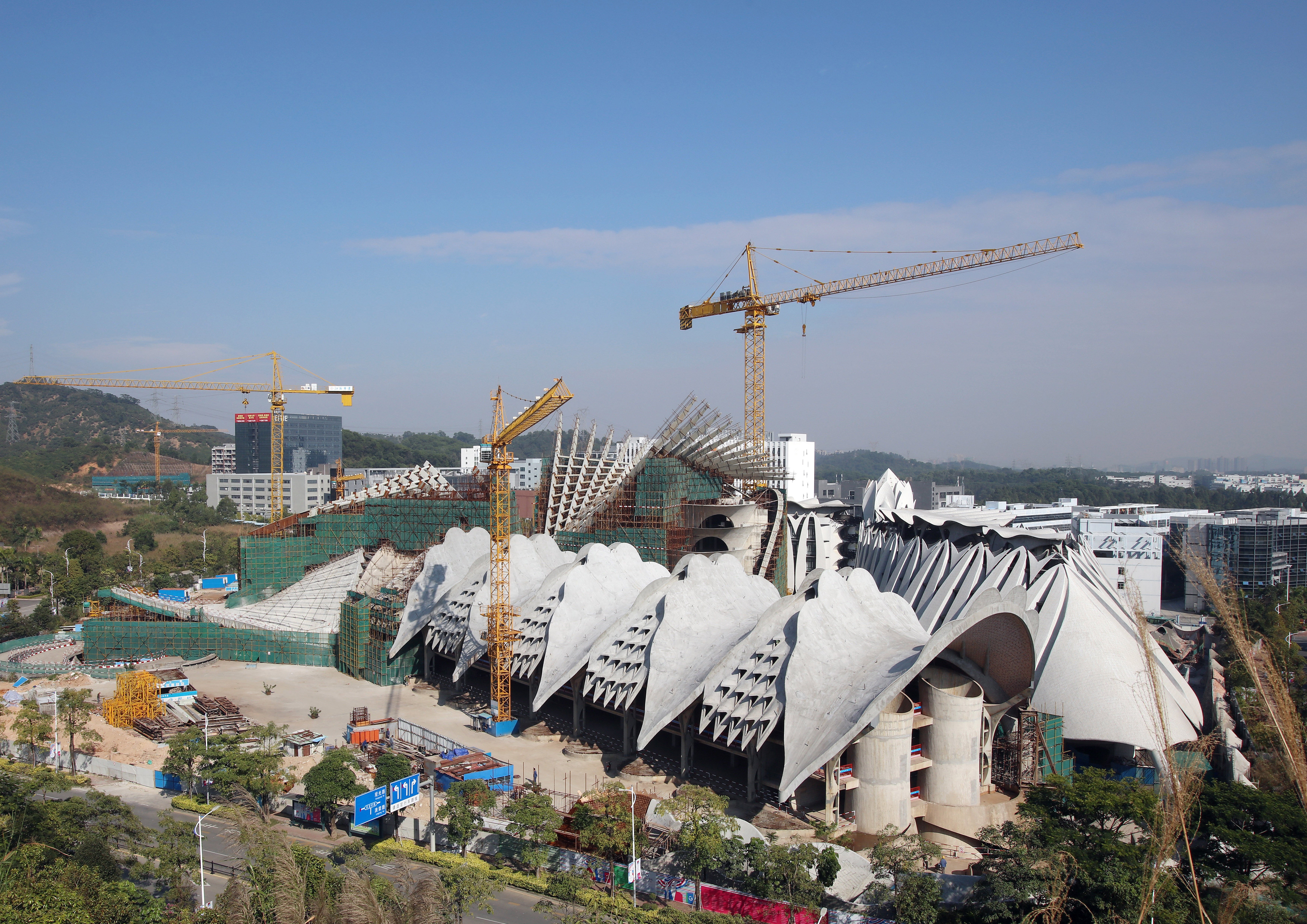


A design inspired by nature.
Built using recycled materials.
Wrapped in a cladding of miniature solar panels, providing power to its surroundings.
And full of the skilled workers needed to find solutions to the climate crisis threatening Dunedin and the world.
Now imagine not just one building, but a whole campus of them, clustered together on Dunedin's waterfront.
A cluster designed to an architectural master plan, pulling in tourists as well as new businesses, in a city striving to be great.
A centre of excellence that produces high-value jobs and intellectual property for solutions to sea-level rise that could be rolled out globally.
And think of the one word that underpins it all - sustainability.
That is the vision proposed by Damien van Brandenburg and Dunedin businessman Ian Taylor.
"If we are looking for a direction the city takes, that will guarantee its future, being the centre of excellence around climate change and sustainability is the best place to be,'' Mr Taylor says.
"It ain't going away.''
Now, stifle the scoffs and the eye-rolls, and instead get on a plane to China.
There, in the southern city of Shenzhen, another of Mr van Brandenburg's projects is already taking shape.
Work on the sprawling Marisfrolg Headquarters - being built for one of China's leading high-end fashion labels - began in 2008 and is due for completion in 2020.
Once finished, the 120,000sq m complex - roughly four times the size of Wellington's Te Papa - will house a boutique hotel and a mix of restaurants, clubs, stores and a spa centre.
Such is the scale and ambition of the project, it has already been declared a building of cultural significance in China, and tour buses are among the regular visitors to the site.
And, throughout the complex, the same design ethos proposed for Dunedin's waterfront is already on display, Mr van Brandenburg said.

Smashed ceramic tiles - some discarded due to simple manufacturing defects - were also used in the construction, as was stone sourced strictly from the nearest quarry.
Together, the materials give the building an aged texture, while its shapes, including the giant leaf-shaped structures forming the roof, mimick nature's "architecture''.
The roof collects rainwater for reuse inside the building and to irrigate surrounding gardens, as well as supplying a pond that draws in the prevailing wind, cooling the entire complex.
Engineers in China initially dismissed the plans as unworkable, but techniques developed by Mr van Brandenburg in Dunedin reduced costs and delivered solutions.
And, throughout it all, the inspiration derived from nature was key, he said.
"If you think about what's evolved over millennia, the types of structures that nature has developed are not rectangular boxes that we now create as humans.
"If you apply that kind of thinking to architecture, that's what we've done with Marisfrolg,'' he said.
His approach was put to the test in September, when Super Typhoon Mangkhut slammed into southern China, forcing 2.45 million people to evacuate.
In Shenzhen, wind striking rectangular buildings created a swirling vortex, sucking out windows and flattening nearby trees.
But within the Marisfrolg site, Mr van Brandenburg's building was unscathed and only one tree was left "on a bit of a lean''.
The winds had funnelled through and over the Marisfrolg's organic shapes.
"It was designed by nature.''

Its design includes a barrier of leaf fronds jutting upwards, providing shelter from the wind and protection from the drop below.
The fronds would also be covered in solar panels, able to pivot to follow the sun, providing power to buildings underneath either end of the bridge's span, he said.
"That sets the tone for what the rest of the development needs to be like,'' he said.
The shell-shaped cultural centre - mooted as a potential home for Ralph Hotere's works, or parts of Te Papa's national collection - would also be covered in a new composite cladding of miniature solar panels.
The micro-solar panels and cladding are existing technologies, but combining the two will be new, and Mr van Brandenburg is already working on the concept with an Australian company.
The approach would turn the cultural centre into a solar power station capable of generating electricity for itself and surrounding buildings, including the five-star hotel.

The same technique was already in use at the Marisfrolg site, and the aim was to go beyond carbon-neutral thinking by returning power to the grid, he said.
"I think we need to be thinking like this now.''
The emphasis on nature would come in other ways, too, including a new Sustainable Futures building - potentially occupied by the University of Otago - designed in the shape of a whale's tail.
The shape referenced the past, when southern right whales calved in Otago Harbour, and hopes for a cleaner future which encouraged their return, he said.
Green technology developed by new businesses on the waterfront could accelerate that, he believed.
More than 1000 trees would also be planted, providing shelter from the wind but also a new habitat for birds, he said.
But, for Mr Taylor, the environmental focus did not stop there.
The entire development would also position Dunedin as an international centre of excellence focused on climate change, sea-level rise and sustainability.
That began with earthworks to lift the area, to ensure the entire development could cope with expected sea-level rise in the years ahead.
But the buildings would also provide a research and development base, generating solutions - and the associated intellectual property rights - for environmental challenges faced around the world.
The Sustainable Futures building could be a base for University of Otago and international marine scientists, closer than any other to the Southern Ocean.
It would also be in close proximity to South Dunedin, considered the best example in New Zealand of a community under threat from sea-level rise.
The resulting innovations would draw new businesses to Dunedin, creating high-value jobs and innovations with sustainable economic and environmental benefits for the city.
"People think we should be dealing to South Dunedin and not doing this. This is how we bring a global focus, as the city of sustainability, to the issues this city has.
"It will apply globally,'' Mr Taylor said.
It would also make Dunedin less reliant on outside entities - think Mondelez and Cadbury's - for its continued economic prosperity, he said.
"We're now not a manufacturer of trains and carriages or chocolates . . . we're a high-end, high-value, IP creation place, and we're putting a focus on things that are sustainable, because that's the biggest growth market in the world.''

THE architecture itself would also encourage a more sustainable approach to tourism in the South Island, he believed.
The connection between Mr van Brandenburg's striking Marisfrolg project and Dunedin's waterfront would draw tourists to the city, Mr Taylor believed.
And, in doing so, it would take pressure off Queenstown, where a tourist boom was continuing to put pressure on the community and existing infrastructure.
The resort's airport had recently proposed expanded noise boundaries to cope with an expect doubling of passenger numbers, to 5.1 million a year, by 2045.
An outcry saw the plan shelved, but greater use of Wanaka airport suggested instead, as a second entry to Queenstown.
Mr Taylor said any scheme that flooded Queenstown with more tourists was a "death trap''.
"That's Venice, and not a single local lives in Venice any more.''
Instead, Dunedin's waterfront project would diversify South Island tourism and allow for more sustainable growth, he said.
But there were still challenges to overcome.
One emerged last month, when it was revealed the waterfront plan was being modified to address commercial viability challenges.
Project partners, led by the Dunedin City Council, were seeking a multimillion-dollar grant, potentially topping $50 million, from the Government's $3 billion Provincial Growth Fund (PGF).
But the Ministry of Business, Innovation and Employment required a business case showing the project was viable before funding could be unlocked.
The assessment centred on estimated development costs per square metre, compared with what people were prepared to pay, at present, for things like a building tenancy in Dunedin.
Changes included moving the location of new buildings inland slightly, which avoided the need to reclaim land, lowering the cost and side-stepping some consent risks.
Mr van Brandenburg said the change did not compromise the overall vision, and would actually improve the environmental outcome.
But more extreme changes to building designs - moving them back to a more "traditional'' design - had been resisted, Mr Taylor said.
That would not be in keeping with the message underpinning the vision, he believed.
"They can't be that.''
Instead, the tweaks agreed to meant the project now met MBIE's requirements, setting a baseline which was commercially viable, Mr Taylor said.
And, without increasing costs again, Mr Taylor and Mr van Brandenburg said they had "no intention'' of being limited to the baseline.

One example was already on show in Queenstown, where Mr van Brandenburg had employed an Australian firm - which had switched from boat-building to architectural production - to fabricate non-traditional, curved forms at reduced costs.
"We believe there are ways we can do it without those constraints that retains the whole vision of the place,'' Mr Taylor said.
In the meantime, interest in the development continues to grow.
The DCC, University of Otago, Port Otago and Ngai Tahu had all signed a memorandum of understanding supporting the project, and a new waterfront agency to drive development was set to be unveiled.
Council chief executive Sue Bidrose has said what was once a 30-year vision is now a "5 to 15-year'' one, and hotel developers were among those lining up to be involved.
Regional Economic Development Minister Shane Jones has also lauded the project's potential to be "iconic and transformational'' for the city and New Zealand.
All of which made next month's application for a substantial Growth Fund grant grant a key milestone, although a cabinet decision is not expected until early next year.
If approved, the funds would pay for the extensive work needed to prepare the site for development - including seawall upgrades and lifting surrounding land.
"We only get one shot at this. By December, our application is in and we either win or lose,'' Mr Taylor said.
"We get this, and everything starts to roll.''
Comments
Amazing!!! Let's do this!!!
It all sounds wonderful but let's be clear, they are not doing this for the environment. Nor are they doing this for the tourists or the art collections or the people of Dunedin. They are doing this for themselves, a business interest, an investment and maybe even self promotion. As such the money needs to come from private investors, investors that can see a direct return for their money. NOT THE RATEPAYERS. There are many ways to raise money for business ventures but forcing the poor and less wealthy people of Dunedin to pay is nothing short of a con.
I believe both of these men believe in Dunedin and are passionate advocates for our city and the environment. This could be the making of our city - future proofing us and providing so many fantastic jobs for our children and grandchildren. It's visionary and doable and will richly reward the city and it's citizens for generations to come.
Many people fought 160 - 150 years ago to prevent the establishment of Otago university because of it's significant cost.
But visionaries who believed in our city pushed forward against those saying it was an expensive waste of public money.
Thank goodness they fought tooth and nail for the establishment of Otago university. Or this city would be a poor backwater now.
This city will only survive and thrive by being truly innovative and utilising our environmental and knowledge economy.
There will be significant private, international and government funding for this.
Let's do this!
Nobody is being forced Pat, least of all the poor. It will attract significant private, international and government funding and become a waterfront that rich and poor can enjoy (unlike the stadium).
I am not against the development of the harbour, only that ratepayers money should be used. I suggest that the developers form a company, one that yourself and LouLou can buy shares in. Might even make you rich! As for nobody being forced you are wrong, ratepayers are already expected to carry the burden of the $20,000,000 bridge, ratepayers have already paid for all the councils promotional and legal work for the development (not to mention endless meetings, reports, plans and consultations), the governments economic development money comes from the taxes we pay and much of the land is publicly owned. Ian Taylor is a business man, this is business, if you want to give your money to him in support I'm sure he will gratefully except it, however I'd rather have a lower rates and tax bill so I can invest into my own business.
What a joke,absolutely sickening,hideous monstrosity,a blatant rip of the Sydney Opera House, etc etc the list goes on,just vile.
Not only is it a cheap ripoff of the Sydney opera house, to claim its going to be sustainable seems rather cynical. After all its going to be mostly build from concrete - the most unsustainable building material in existence. You'll need to put a lot of solar panels on it to make up for the climate damage it will cause. Start building with wood and then regrow the forest - that is a step in the right direction. Just look at the Brock Commons high rise in Vancouver for inspiration. And don't build any more of those horrible plastic looking monstrosities that are popping up all over China. That is not the future or cool, that is soo yesterday. Nothing to celebrate with that design.
Lou Lou I agree wholeheartedly with your comments. I think this will make Dunedin. We are so lucky to have such creativity here in Dunedin and the support of so many. It will attract significant private, international and government funding and become a destination alongside a heritage city. These two men deserve our applause- and they are locals!
Wild idea. Now stop wanting the ratepayers to pay for it. We're still paying off the *&&^% stadium.
Wed 28/11 Did any of the above commenters go to the presentation at the library last night? This was the opportunity to ask questions. The architect Damian Van Brandenburg is a local and knows the harbour intimately as he has has a studio there for an equally stunning Marisfrolg project he's working on in China. He described the origins of his harbour design and how it will be funded (Not by ratepayers). If Heritage NZ and the Southern Heritage Trust are enthusiastic about it, that displays a nod at its high quality design and value for Dunedin. It is a heritage site of the future and one locals a visitors will enjoy and travel to see. It is stunning!











